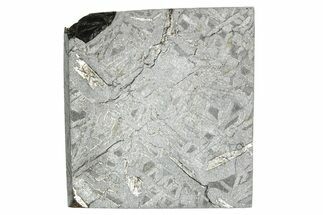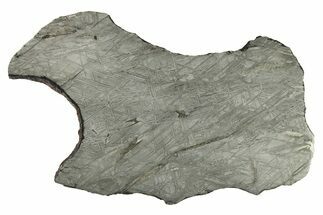8.75" Etched Soledade Iron Meteorite (583 g) Slice - Brazil
This is a gorgeous, 8.75" wide (583 gram) etched slice of the Soledade iron meteorite from Brazil. It shows very nice Widmanstätten patterns and has been fully stabilized through reverse electrolysis.
Comes with an acrylic display stand.
Comes with an acrylic display stand.
The Soledade Meteorite
This coarse octahedrite was discovered in 1986 as a 68 kg mass being heated with a torch and hammered in a garage near the city of Soledade, Brazil. The initial discovery of this meteorite was before 1982. When etched, this meteorite displays wonderful, interlocking Widmanstätten lines.
Meteoritical Bulletin: Entry for Soledade
This coarse octahedrite was discovered in 1986 as a 68 kg mass being heated with a torch and hammered in a garage near the city of Soledade, Brazil. The initial discovery of this meteorite was before 1982. When etched, this meteorite displays wonderful, interlocking Widmanstätten lines.
Meteoritical Bulletin: Entry for Soledade
About Iron Meteorites
Iron type meteorites are composed primarily of iron and nickel, and are the remnants of differential cores torn apart at the beginning of the solar system. These metallic meteorites are often the easiest to identify after millions of years post-impact because they are quite different from terrestrial material, especially when it comes to their mass-to-surface area ratio. They are exceptionally heavy for their size since iron is a high-density metal: this is also why the Earth's core is nickel-iron. As planets form, the densest metals form gravitational centers, bringing more and more material into their gravitational pull. In the solar system's rocky planets, these dense materials are most often nickel and iron.
Most iron meteorites have distinctive, geometric patterns called Widmanstätten patterns, which become visible when the meteorite is cut and acid etched. These patterns are criss-crossing bands of the iron-nickel alloys kamacite and taenite that slowly crystalized as the core of the meteorites' parent bodies slowly cooled. Such large alloy crystallizations for mover millions of years and do not occur naturally on Earth, further proving that iron meteorites come from extraterrestrial bodies.
Iron type meteorites are composed primarily of iron and nickel, and are the remnants of differential cores torn apart at the beginning of the solar system. These metallic meteorites are often the easiest to identify after millions of years post-impact because they are quite different from terrestrial material, especially when it comes to their mass-to-surface area ratio. They are exceptionally heavy for their size since iron is a high-density metal: this is also why the Earth's core is nickel-iron. As planets form, the densest metals form gravitational centers, bringing more and more material into their gravitational pull. In the solar system's rocky planets, these dense materials are most often nickel and iron.
Most iron meteorites have distinctive, geometric patterns called Widmanstätten patterns, which become visible when the meteorite is cut and acid etched. These patterns are criss-crossing bands of the iron-nickel alloys kamacite and taenite that slowly crystalized as the core of the meteorites' parent bodies slowly cooled. Such large alloy crystallizations for mover millions of years and do not occur naturally on Earth, further proving that iron meteorites come from extraterrestrial bodies.
$2,325
TYPE
Iron, IAB-MG
LOCATION
Soledade, Rio Grande do Sul, Brazil
SIZE
8.75 x 3.81", .27" thick, Weight: 583 grams
CATEGORY
ITEM
#301214
 Reviews
Reviews









